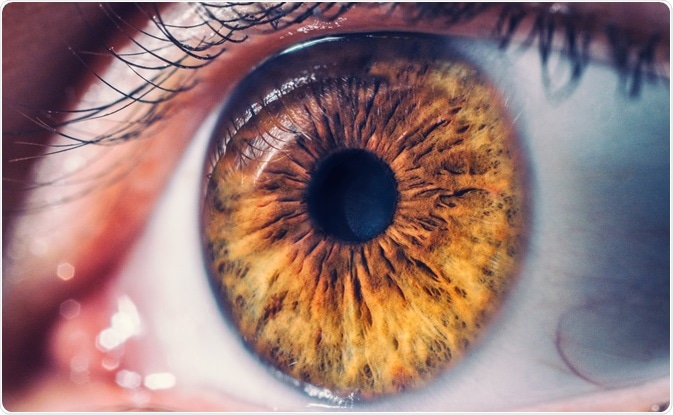The Use of Nanosensors to Restore Retinal Vision

Researchers from Tübingen University, Germany have determined a method to sensitize the retina to light by selectively targeting failed photoreceptors. Combined with gene therapy, the team engineered nanosensors &, succeeded in inducing infrared light sensitivity in the retina to restore vision.

Image Credit: hispan/Shutterstock.com
The team’s approach prevents hyper saturation of photoreceptors, reducing damage to photoreceptors housed in the retina alongside the nanosensor-mediated restoration of light-sensitive vision.
Photoreceptors in the retina control vision in low light
Vision is controlled by an array of neurons in the eye which convert light into electrical signals in the specialized photoreceptors in the retina of the eye. Of these, rod cells function in low levels of light and are the dominant active cells in night vision.
When photoreceptors become degenerated, they are no longer sensitive to light. This renders individuals blind (or partially sighted) as photoreceptors cannot activate second and third-order neurons that carry visual information to the brain.
Rod cells do not regenerate; therapies that combat degenerative blindness aim to slow and preserve remaining vision; once degeneration is slowed, vision restoration is attempted. This latter aim is achieved by stem-cell approaches and targeted gene therapy
Nanosensors conferring infrared vision: restoring vision in the blind
Nelidova et al.’s approach focussed on resensitizing the retina to infrared light which circumvents problems associated with the optogenetic approach to light-sensitive vision.
Optogenetic gene therapies induce the expression of the light-sensitive ion channels in ‘candidate molecules’. These candidates often have a greater threshold for activation relative to normal photoreceptors. For patients with remaining vision, this strategy risks saturation and damage of remaining functional photoreceptors.
Infrared light does not carry the risk of retinal saturation and damage. Nelidova et al. employed gold nanorods as an infrared light ‘antenna’ which transformed the light into heat via a process of surface plasmon resonance.
Photoreceptors were engineered with genetic constructs, enabling their expression of temperature-sensitive transient receptor potential (TRP) channels. TRP channels are found in heat-sensitive nerves of mammalian skin and convert heat into electrical potential differences across cell membranes.
By linking the heat-emitting gold nanoparticles to the TRP-expressing photoreceptors using antibodies, infrared light was harnessed to activate photoreceptors in the retina. The nanorod-emitted heat opens the TRP channel, inducing a current in the photoreceptor which activates downstream pathways for visual perception.
Proof of concept: making blind retinas see again
To ensure that restoration of vision was possible, the team expressed these TRP expressing channels in the cone photoreceptors of mice. Neural activity in the retina was found in response to infrared stimulation.
The team found that changing the length of the gold nanorods resulted in a tunable system capable of responding to different infrared wavelengths.
When testing the approach in post-mortem human retinas, infrared light stimulation achieved light sensitivity and vision. This human model for testing is critical for evaluating the relevance of the nanorod–TRP channel approach in humans.
This provided a proof of principle for translation, alongside establishing a model for the study of human retinal cell type and circuit function.
The nanorod–TRP channel approach used by Nelidova et al. is compatible with remaining vision and promises future translation in patients. Although both ocular therapies and the use of gold nanorods have proven safe and effective, limitations remain.
The limitations of infrared-sensitive nanorods in vision restoration
Ocular gene therapy is limited by efficiency and completeness of genetic manipulation – with long-term effectiveness remaining a challenge. The approach cannot target degenerating photoreceptors selectively and so, investigation of healthy photoreceptors is necessary.
The overarching limitation is the ability of this technique to work in practice. Many objects do not emit or reflect infrared light which would result in mandatory use of goggles in patients to convert visible to infrared light for complete vision.
Despite these practical limitations, this study provides a strong foundation of basic research. With the development of tools for the reintroduction of light sensitivity to post-mortem retina, options for the study of human retinal function in great detail will become possible – revealing the functions of vision that must be targeted for restoration.
Sources
- Nelidova, D. et al. (2020) Restoring light sensitivity using tunable near-infrared sensors. Science. DOI: 10.1126/science.aaz5887
- Franke, K. & Vlasits, A. (2020) Unblinding with infrared nanosensors. Science. DOI: 10.1126/science.abc2294
Last Updated: Sep 11, 2020

Written by
Hidaya Aliouche
Hidaya is a science communications enthusiast who has recently graduated and is embarking on a career in the science and medical copywriting. She has a B.Sc. in Biochemistry from The University of Manchester. She is passionate about writing and is particularly interested in microbiology, immunology, and biochemistry.
Source: Read Full Article